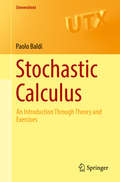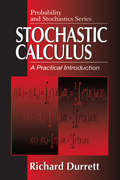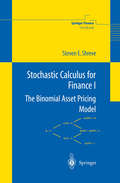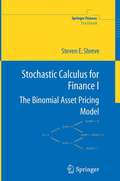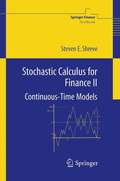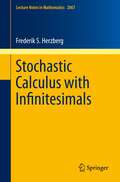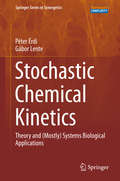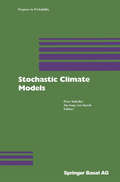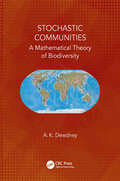- Table View
- List View
Stochastic Benchmarking: Theory and Applications (International Series in Operations Research & Management Science #317)
by Alireza Amirteimoori Biresh K. Sahoo Vincent Charles Saber MehdizadehThis book introduces readers to benchmarking techniques in the stochastic environment, primarily stochastic data envelopment analysis (DEA), and provides stochastic models in DEA for the possibility of variations in inputs and outputs. It focuses on the application of theories and interpretations of the mathematical programs, which are combined with economic and organizational thinking. The book’s main purpose is to shed light on the advantages of the different methods in deterministic and stochastic environments and thoroughly prepare readers to properly use these methods in various cases. Simple examples, along with graphical illustrations and real-world applications in industry, are provided for a better understanding. The models introduced here can be easily used in both theoretical and real-world evaluations. This book is intended for graduate and PhD students, advanced consultants, and practitioners with an interest in quantitative performance evaluation.
Stochastic Biomathematical Models: with Applications to Neuronal Modeling (Lecture Notes in Mathematics #2058)
by Mostafa Bachar, Jerry Batzel and Susanne DitlevsenStochastic biomathematical models are becoming increasingly important as new light is shed on the role of noise in living systems. In certain biological systems, stochastic effects may even enhance a signal, thus providing a biological motivation for the noise observed in living systems. Recent advances in stochastic analysis and increasing computing power facilitate the analysis of more biophysically realistic models, and this book provides researchers in computational neuroscience and stochastic systems with an overview of recent developments. Key concepts are developed in chapters written by experts in their respective fields. Topics include: one-dimensional homogeneous diffusions and their boundary behavior, large deviation theory and its application in stochastic neurobiological models, a review of mathematical methods for stochastic neuronal integrate-and-fire models, stochastic partial differential equation models in neurobiology, and stochastic modeling of spreading cortical depression.
Stochastic Calculus: An Introduction Through Theory and Exercises (Universitext)
by Paolo BaldiThis book provides a comprehensive introduction to the theory of stochastic calculus and some of its applications. It is the only textbook on the subject to include more than two hundred exercises with complete solutions.After explaining the basic elements of probability, the author introduces more advanced topics such as Brownian motion, martingales and Markov processes. The core of the book covers stochastic calculus, including stochastic differential equations, the relationship to partial differential equations, numerical methods and simulation, as well as applications of stochastic processes to finance. The final chapter provides detailed solutions to all exercises, in some cases presenting various solution techniques together with a discussion of advantages and drawbacks of the methods used. Stochastic Calculus will be particularly useful to advanced undergraduate and graduate students wishing to acquire a solid understanding of the subject through the theory and exercises. Including full mathematical statements and rigorous proofs, this book is completely self-contained and suitable for lecture courses as well as self-study.
Stochastic Calculus: A Practical Introduction (Probability and Stochastics Series)
by Richard DurrettThis compact yet thorough text zeros in on the parts of the theory that are particularly relevant to applications . It begins with a description of Brownian motion and the associated stochastic calculus, including their relationship to partial differential equations. It solves stochastic differential equations by a variety of methods and studies in detail the one-dimensional case. The book concludes with a treatment of semigroups and generators, applying the theory of Harris chains to diffusions, and presenting a quick course in weak convergence of Markov chains to diffusions. The presentation is unparalleled in its clarity and simplicity. Whether your students are interested in probability, analysis, differential geometry or applications in operations research, physics, finance, or the many other areas to which the subject applies, you'll find that this text brings together the material you need to effectively and efficiently impart the practical background they need.
Stochastic Calculus: A Practical Introduction (Probability and Stochastics Series)
by Richard DurrettThis compact yet thorough text zeros in on the parts of the theory that are particularly relevant to applications . It begins with a description of Brownian motion and the associated stochastic calculus, including their relationship to partial differential equations. It solves stochastic differential equations by a variety of methods and studies in detail the one-dimensional case. The book concludes with a treatment of semigroups and generators, applying the theory of Harris chains to diffusions, and presenting a quick course in weak convergence of Markov chains to diffusions. The presentation is unparalleled in its clarity and simplicity. Whether your students are interested in probability, analysis, differential geometry or applications in operations research, physics, finance, or the many other areas to which the subject applies, you'll find that this text brings together the material you need to effectively and efficiently impart the practical background they need.
Stochastic Calculus: Applications in Science and Engineering
by Mircea GrigoriuAlgebraic, differential, and integral equations are used in the applied sciences, en gineering, economics, and the social sciences to characterize the current state of a physical, economic, or social system and forecast its evolution in time. Generally, the coefficients of and/or the input to these equations are not precisely known be cause of insufficient information, limited understanding of some underlying phe nomena, and inherent randonmess. For example, the orientation of the atomic lattice in the grains of a polycrystal varies randomly from grain to grain, the spa tial distribution of a phase of a composite material is not known precisely for a particular specimen, bone properties needed to develop reliable artificial joints vary significantly with individual and age, forces acting on a plane from takeoff to landing depend in a complex manner on the environmental conditions and flight pattern, and stock prices and their evolution in time depend on a large number of factors that cannot be described by deterministic models. Problems that can be defined by algebraic, differential, and integral equations with random coefficients and/or input are referred to as stochastic problems. The main objective of this book is the solution of stochastic problems, that is, the determination of the probability law, moments, and/or other probabilistic properties of the state of a physical, economic, or social system. It is assumed that the operators and inputs defining a stochastic problem are specified.
Stochastic Calculus and Applications (Probability and Its Applications)
by Samuel N. Cohen Robert J. ElliottCompletely revised and greatly expanded, the new edition of this text takes readers who have been exposed to only basic courses in analysis through the modern general theory of random processes and stochastic integrals as used by systems theorists, electronic engineers and, more recently, those working in quantitative and mathematical finance. Building upon the original release of this title, this text will be of great interest to research mathematicians and graduate students working in those fields, as well as quants in the finance industry.New features of this edition include:End of chapter exercises; New chapters on basic measure theory and Backward SDEs; Reworked proofs, examples and explanatory material; Increased focus on motivating the mathematics; Extensive topical index."Such a self-contained and complete exposition of stochastic calculus and applications fills an existing gap in the literature. The book can be recommended for first-year graduate studies. It will be useful for all who intend to work with stochastic calculus as well as with its applications."–Zentralblatt (from review of the First Edition)
Stochastic Calculus and Financial Applications (Stochastic Modelling and Applied Probability #45)
by J. Michael SteeleStochastic calculus has important applications to mathematical finance. This book will appeal to practitioners and students who want an elementary introduction to these areas. From the reviews: "As the preface says, ‘This is a text with an attitude, and it is designed to reflect, wherever possible and appropriate, a prejudice for the concrete over the abstract’. This is also reflected in the style of writing which is unusually lively for a mathematics book." --ZENTRALBLATT MATH
Stochastic Calculus for Finance I: The Binomial Asset Pricing Model (Springer Finance)
by Steven ShreveDeveloped for the professional Master's program in Computational Finance at Carnegie Mellon, the leading financial engineering program in the U.S. Has been tested in the classroom and revised over a period of several years Exercises conclude every chapter; some of these extend the theory while others are drawn from practical problems in quantitative finance
Stochastic Calculus For Finance I: The Binomial Asset Pricing Model (PDF)
by Steven E. ShreveDeveloped for the professional Master's program in Computational Finance at Carnegie Mellon, the leading financial engineering program in the U.S. Has been tested in the classroom and revised over a period of several years. Exercises conclude every chapter; some of these extend the theory while others are drawn from practical problems in quantitative finance.
Stochastic Calculus for Finance II: Continuous-time Models (Springer Finance Ser. (PDF))
by Steven E. Shreve"A wonderful display of the use of mathematical probability to derive a large set of results from a small set of assumptions. In summary, this is a well-written text that treats the key classical models of finance through an applied probability approach....It should serve as an excellent introduction for anyone studying the mathematics of the classical theory of finance." --SIAM
Stochastic Calculus for Fractional Brownian Motion and Applications (Probability and Its Applications)
by Francesca Biagini Yaozhong Hu Bernt Øksendal Tusheng ZhangThe purpose of this book is to present a comprehensive account of the different definitions of stochastic integration for fBm, and to give applications of the resulting theory. Particular emphasis is placed on studying the relations between the different approaches. Readers are assumed to be familiar with probability theory and stochastic analysis, although the mathematical techniques used in the book are thoroughly exposed and some of the necessary prerequisites, such as classical white noise theory and fractional calculus, are recalled in the appendices. This book will be a valuable reference for graduate students and researchers in mathematics, biology, meteorology, physics, engineering and finance.
Stochastic Calculus for Fractional Brownian Motion and Related Processes (Lecture Notes in Mathematics #1929)
by Yuliya MishuraThis volume examines the theory of fractional Brownian motion and other long-memory processes. Interesting topics for PhD students and specialists in probability theory, stochastic analysis and financial mathematics demonstrate the modern level of this field. It proves that the market with stock guided by the mixed model is arbitrage-free without any restriction on the dependence of the components and deduces different forms of the Black-Scholes equation for fractional market.
Stochastic Calculus for Quantitative Finance
by Alexander A GushchinIn 1994 and 1998 F. Delbaen and W. Schachermayer published two breakthrough papers where they proved continuous-time versions of the Fundamental Theorem of Asset Pricing. This is one of the most remarkable achievements in modern Mathematical Finance which led to intensive investigations in many applications of the arbitrage theory on a mathematically rigorous basis of stochastic calculus. Mathematical Basis for Finance: Stochastic Calculus for Finance provides detailed knowledge of all necessary attributes in stochastic calculus that are required for applications of the theory of stochastic integration in Mathematical Finance, in particular, the arbitrage theory. The exposition follows the traditions of the Strasbourg school. This book covers the general theory of stochastic processes, local martingales and processes of bounded variation, the theory of stochastic integration, definition and properties of the stochastic exponential; a part of the theory of Lévy processes. Finally, the reader gets acquainted with some facts concerning stochastic differential equations.Contains the most popular applications of the theory of stochastic integrationDetails necessary facts from probability and analysis which are not included in many standard university courses such as theorems on monotone classes and uniform integrabilityWritten by experts in the field of modern mathematical finance
Stochastic Calculus in Manifolds (Universitext)
by Michel EmeryAddressed to both pure and applied probabilitists, including graduate students, this text is a pedagogically-oriented introduction to the Schwartz-Meyer second-order geometry and its use in stochastic calculus. P.A. Meyer has contributed an appendix: "A short presentation of stochastic calculus" presenting the basis of stochastic calculus and thus making the book better accessible to non-probabilitists also. No prior knowledge of differential geometry is assumed of the reader: this is covered within the text to the extent. The general theory is presented only towards the end of the book, after the reader has been exposed to two particular instances - martingales and Brownian motions - in manifolds. The book also includes new material on non-confluence of martingales, s.d.e. from one manifold to another, approximation results for martingales, solutions to Stratonovich differential equations. Thus this book will prove very useful to specialists and non-specialists alike, as a self-contained introductory text or as a compact reference.
Stochastic Calculus of Variations in Mathematical Finance (Springer Finance)
by Paul Malliavin Anton ThalmaierHighly esteemed author Topics covered are relevant and timely
Stochastic Calculus via Regularizations (Bocconi & Springer Series #11)
by Francesco Russo Pierre ValloisThe book constitutes an introduction to stochastic calculus, stochastic differential equations and related topics such as Malliavin calculus. On the other hand it focuses on the techniques of stochastic integration and calculus via regularization initiated by the authors. The definitions relies on a smoothing procedure of the integrator process, they generalize the usual Itô and Stratonovich integrals for Brownian motion but the integrator could also not be a semimartingale and the integrand is allowed to be anticipating. The resulting calculus requires a simple formalism: nevertheless it entails pathwise techniques even though it takes into account randomness. It allows connecting different types of pathwise and non pathwise integrals such as Young, fractional, Skorohod integrals, enlargement of filtration and rough paths. The covariation, but also high order variations, play a fundamental role in the calculus via regularization, which can also be applied for irregular integrators. A large class of Gaussian processes, various generalizations of semimartingales such that Dirichlet and weak Dirichlet processes are revisited. Stochastic calculus via regularization has been successfully used in applications, for instance in robust finance and on modeling vortex filaments in turbulence. The book is addressed to PhD students and researchers in stochastic analysis and applications to various fields.
Stochastic Calculus with Infinitesimals (Lecture Notes in Mathematics #2067)
by Frederik S. HerzbergStochastic analysis is not only a thriving area of pure mathematics with intriguing connections to partial differential equations and differential geometry. It also has numerous applications in the natural and social sciences (for instance in financial mathematics or theoretical quantum mechanics) and therefore appears in physics and economics curricula as well. However, existing approaches to stochastic analysis either presuppose various concepts from measure theory and functional analysis or lack full mathematical rigour. This short book proposes to solve the dilemma: By adopting E. Nelson's "radically elementary" theory of continuous-time stochastic processes, it is based on a demonstrably consistent use of infinitesimals and thus permits a radically simplified, yet perfectly rigorous approach to stochastic calculus and its fascinating applications, some of which (notably the Black-Scholes theory of option pricing and the Feynman path integral) are also discussed in the book.
Stochastic Cauchy Problems in Infinite Dimensions: Generalized and Regularized Solutions (Chapman & Hall/CRC Monographs and Research Notes in Mathematics)
by Irina V. MelnikovaStochastic Cauchy Problems in Infinite Dimensions: Generalized and Regularized Solutions presents stochastic differential equations for random processes with values in Hilbert spaces. Accessible to non-specialists, the book explores how modern semi-group and distribution methods relate to the methods of infinite-dimensional stochastic analysis. It also shows how the idea of regularization in a broad sense pervades all these methods and is useful for numerical realization and applications of the theory. The book presents generalized solutions to the Cauchy problem in its initial form with white noise processes in spaces of distributions. It also covers the "classical" approach to stochastic problems involving the solution of corresponding integral equations. The first part of the text gives a self-contained introduction to modern semi-group and abstract distribution methods for solving the homogeneous (deterministic) Cauchy problem. In the second part, the author solves stochastic problems using semi-group and distribution methods as well as the methods of infinite-dimensional stochastic analysis.
Stochastic Chemical Kinetics: Theory and (Mostly) Systems Biological Applications (Springer Series in Synergetics)
by Péter Érdi Gábor LenteThis volume reviews the theory and simulation methods of stochastic kinetics by integrating historical and recent perspectives, presents applications, mostly in the context of systems biology and also in combustion theory. In recent years, due to the development in experimental techniques, such as optical imaging, single cell analysis, and fluorescence spectroscopy, biochemical kinetic data inside single living cells have increasingly been available. The emergence of systems biology brought renaissance in the application of stochastic kinetic methods.
Stochastic Chemical Reaction Systems in Biology (Lecture Notes on Mathematical Modelling in the Life Sciences)
by Hong Qian Hao GeThis book provides an introduction to the analysis of stochastic dynamic models in biology and medicine. The main aim is to offer a coherent set of probabilistic techniques and mathematical tools which can be used for the simulation and analysis of various biological phenomena. These tools are illustrated on a number of examples. For each example, the biological background is described, and mathematical models are developed following a unified set of principles. These models are then analyzed and, finally, the biological implications of the mathematical results are interpreted. The biological topics covered include gene expression, biochemistry, cellular regulation, and cancer biology. The book will be accessible to graduate students who have a strong background in differential equations, the theory of nonlinear dynamical systems, Markovian stochastic processes, and both discrete and continuous state spaces, and who are familiar with the basic concepts of probability theory.
Stochastic Climate Models (Progress in Probability #49)
by Peter Imkeller Jin-Song Von StorchA collection of articles written by mathematicians and physicists, designed to describe the state of the art in climate models with stochastic input. Mathematicians will benefit from a survey of simple models, while physicists will encounter mathematically relevant techniques at work.
Stochastic Coalgebraic Logic (Monographs in Theoretical Computer Science. An EATCS Series)
by Ernst-Erich DoberkatCoalgebraic logic is an important research topic in the areas of concurrency theory, semantics, transition systems and modal logics. It provides a general approach to modeling systems, allowing us to apply important results from coalgebras, universal algebra and category theory in novel ways. Stochastic systems provide important tools for systems modeling, and recent work shows that categorical reasoning may lead to new insights, previously not available in a purely probabilistic setting. This book combines coalgebraic reasoning, stochastic systems and logics. It provides an insight into the principles of coalgebraic logic from a categorical point of view, and applies these systems to interpretations of stochastic coalgebraic logics, which include well-known modal logics and continuous time branching logics. The author introduces stochastic systems together with their probabilistic and categorical foundations and gives a comprehensive discussion of the Giry monad as the underlying categorical construction, presenting many new, hitherto unpublished results. He discusses modal logics, introduces their probabilistic interpretations, and then proceeds to an analysis of Kripke models for coalgebraic logics. The book will be of interest to researchers in theoretical computer science, logic and category theory.
Stochastic Communities: A Mathematical Theory of Biodiversity
by A. K. DewdneyStochastic Communities presents a theory of biodiversity by analyzing the distribution of abundances among species in the context of a community. The basis of this theory is a distribution called the "J distribution." This distribution is a pure hyperbola and mathematically implied by the "stochastic species hypothesis" assigning equal probabilities of birth and death within the population of each species over varying periods of time. The J distribution in natural communities has strong empirical support resulting from a meta-study and strong theoretical support from a theorem that is mathematically implied by the stochastic species hypothesis.
Stochastic Communities: A Mathematical Theory of Biodiversity
by A. K. DewdneyStochastic Communities presents a theory of biodiversity by analyzing the distribution of abundances among species in the context of a community. The basis of this theory is a distribution called the "J distribution." This distribution is a pure hyperbola and mathematically implied by the "stochastic species hypothesis" assigning equal probabilities of birth and death within the population of each species over varying periods of time. The J distribution in natural communities has strong empirical support resulting from a meta-study and strong theoretical support from a theorem that is mathematically implied by the stochastic species hypothesis.


